Guitar necks are one of the most important elements to consider when shopping for a guitar.
The neck is what determines the overall feel and playability of the instrument, and it can even affect the sound you get out of it.
Knowing the different types of guitar necks, different guitar neck shapes, construction materials, and influencing factors will help you decide when choosing your next guitar.
In this article, we’ll explore all aspects of different guitar necks so that you can make an informed choice when selecting your next axe.
What Is A Guitar Neck?
A guitar neck is the wood between the headstock and body, not to be confused with the fretboard, which is often glued on top. The main difference between a guitar neck and a fretboard is that they can be made of entirely different materials.
Commonly, a guitar neck will be made from mahogany or maple while a fretboard may be constructed out of rosewood or ebony.
Different types of guitars also have varying necks, such as those found on classical guitars, which are usually wider and shallower than regular electric guitars.
Additionally, many manufacturers offer custom shapes and sizes for their necks which further adds to the variety available in the market.
It’s important to note that replacing an existing neck may result in adjusting other components, such as pickups or bridges, depending on your setup, so research before making any changes!
In case your headstock needs replacement, check this guide on how to fix the guitar headstock.
Why Is a Guitar Neck Important?
The guitar neck is a vital part of the instrument, providing stability and affecting the strings’ tone – adding warmth or brightness to each strum. The neck is held in place by a metal beam known as a truss rod that helps counteract the tension from the strings and keeps them in tune.
This stability ensures you get an accurate sound every time you play your guitar.
The material used for the neck also has an effect on its tone, playability, and aesthetics.
Different types of woods will provide different warm or bright tones depending on what suits your playing style best. For example, mahogany provides warmer tones, while maple produces brighter sounds.
Choosing the right type of wood for your guitar neck can be key to getting that perfect sound you’re looking for when playing live or recording in the studio.
What are the influencing factors in neck profile?
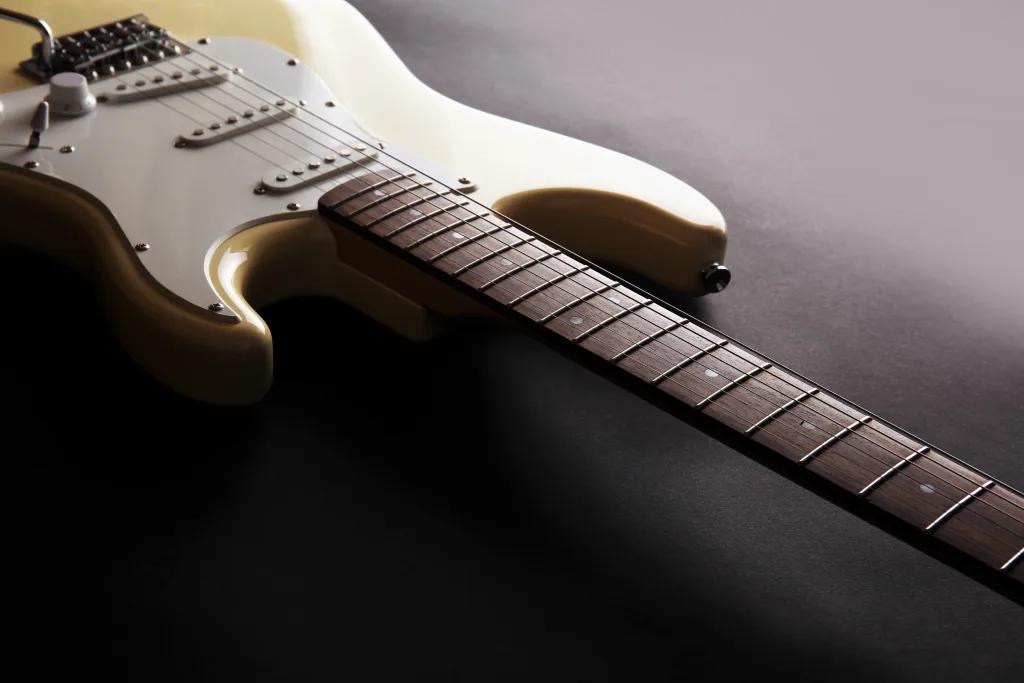
When talking about guitar necks, two of the most important influencing factors to consider are neck depth and neck width. Another factor that makes a big difference is the fretboard radius, which can make a substantial difference in how the instrument feels and plays.
All three of these features contribute significantly to making a guitar neck feel comfortable and easy to play. So, it’s important to pay attention to these factors when choosing a guitar or when customizing a guitar’s neck.
Guitar neck depth
Measuring the depth from the center of the back of the neck to the top of the fretboard is key.
For example, vintage Fender Stratocasters typically had a nut thickness of .087″ and a 12th fret thickness of .098″.
This difference in depth between the nut and 12th fret became more pronounced in 60s guitars. Thinner necks became increasingly popular in the 70s and 80s designs due to genres like speed metal that required greater playing speed.
Neck depth becomes especially important when it comes to string action.
Too much or too little will affect how well you can perform on your instrument. In general, lower action requires less neck relief while higher action needs more relief for easier playability.
Ultimately, finding a balance between these two factors is critical to having an enjoyable playing experience.
Guitar neck width
how wide your guitar neck is can make a big difference in playability and feel.
Generally speaking, the wider the neck, the easier for larger hands to reach chords up and down along its length.
Classical guitars and 12 strings typically have the widest necks, usually measuring 2″ or 1.87″ respectively a t the nut. On average, electric guitar necks come in around 1.69″ wide at the nut – but this does vary from one instrument to another so it’s important to measure yours before making any decisions about which type of guitar might be best for you.
The width of your fretboard also affects string spacing: wider necks often mean more space between each string which makes chord shapes easier to form and less likely you’ll accidentally hit other strings when strumming or picking.
Fretboard radius
Fretboard radius impacts playability significantly, with flatter radii allowing for more single-note playing and bigger bends, while tighter radii make chords easier to play.
Vintage guitars, such as the Stratocaster, have a tighter 7.25″ radius that makes chords easier to play and it’s also found on reissues, relics, new old stock guitars and other vintage guitars.
Most modern Strats come with a 9.5″ radius which is much flatter and is perfect for bending notes up or down.
Gibson guitars usually have an even flatter 12″ radius that facilitates easy chord playing but makes it harder to bend notes accurately.
For an even flatter fretboard, the Strandberg Boden offers an impressive 20″ radius which allows guitarists to easily perform complicated chord shapes but can make single note playing slightly more difficult.
Most common guitar neck shapes
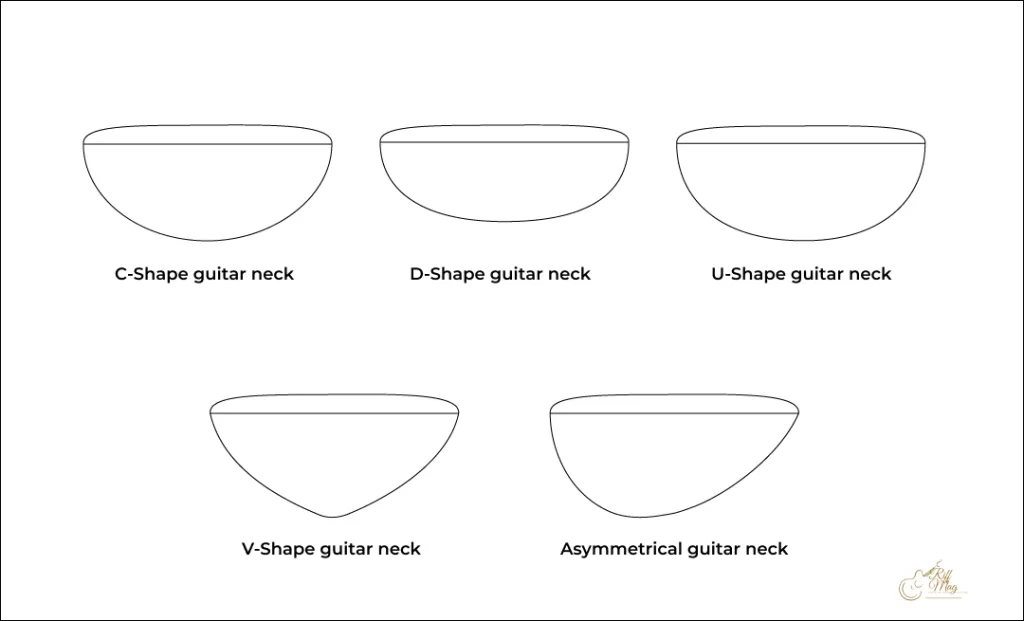
When it comes to different neck shapes, there are several common neck shape that you can choose from.
The most popular include the C-Shape, U-Shape, V-Shape, D-Shape, and Asymmetrical guitar necks.
Each of these shapes offers different levels of playability and comfort for the musician playing.
They should be chosen based on personal preference.
All of these neck types also have their own unique look, which can help set your instrument apart from others in the crowd.
C-Shape guitar necks
 If you’re looking for a comfortable neck to play on, the C shape neck is usually an excellent choice. This shape has been around since the 80s when Fender switched production and made it their primary neck profile for most of their instruments. It’s become the go-to option for guitarists ever since due to its comfort and playability.
If you’re looking for a comfortable neck to play on, the C shape neck is usually an excellent choice. This shape has been around since the 80s when Fender switched production and made it their primary neck profile for most of their instruments. It’s become the go-to option for guitarists ever since due to its comfort and playability.
The C-shaped neck is popular among many players, but those with large hands may find it difficult to handle. Popular instruments that feature this shape include the American Standard Strat/Tele, and ’61/’59 Gibson SG.
U-Shape guitar necks
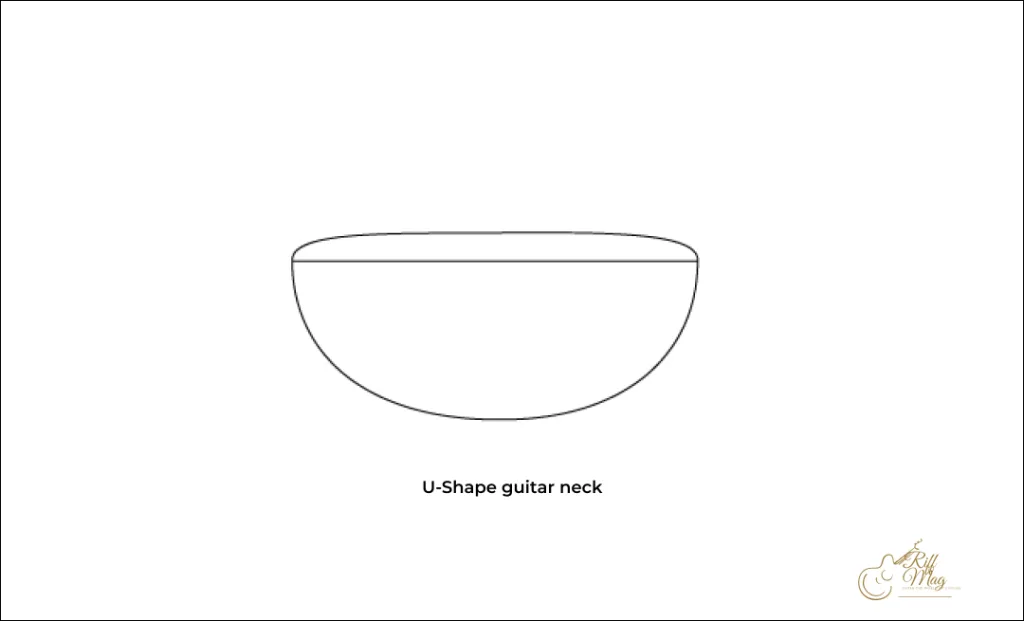 In contrast to the C-shaped guitar neck, a U-shaped neck is much more robust and bulky. It has a rounder back than the C shape, which makes it incredibly comfortable for those with larger hands.
In contrast to the C-shaped guitar neck, a U-shaped neck is much more robust and bulky. It has a rounder back than the C shape, which makes it incredibly comfortable for those with larger hands.
They have been compared to baseball bats due to their thick girth and cylindrical shape, making them very popular amongst vintage Fender and Gibson models from the 1950s.
Examples of guitars that feature U-shaped necks include the ’52 Telecaster and the 50s Les Paul Standard – both of which are highly sought after by players seeking an old-school sound.
V-Shape guitar necks
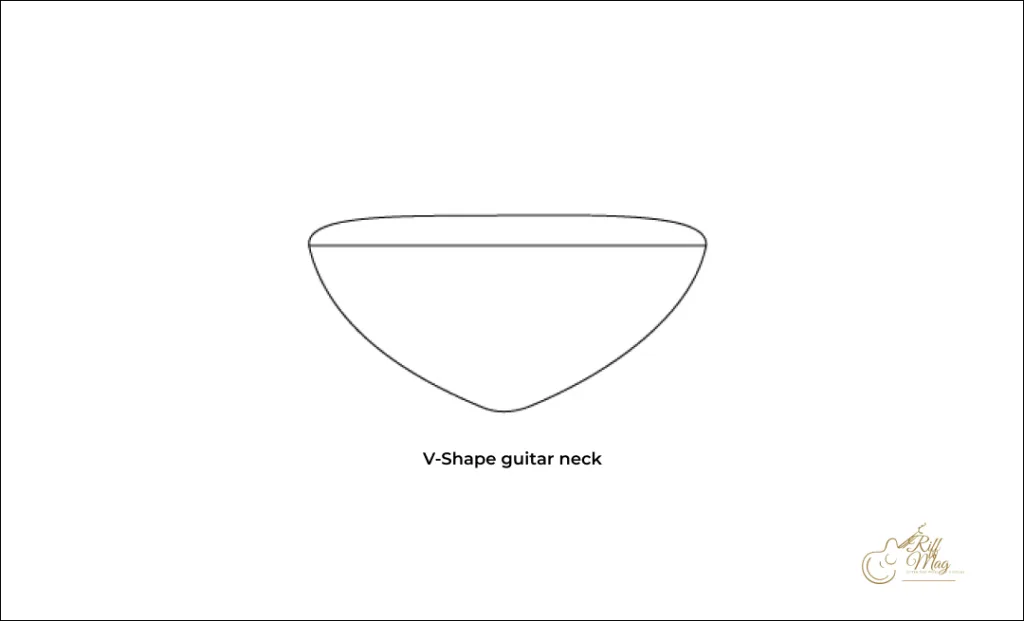
The V-shaped neck is one of the oldest designs and is split into either V soft or V hard, with the latter having a pointier apex.
This design allows for players to rest their fret hand thumb on the fretboard, making it ideal for those who prefer this style of playing. These necks have become less popular in recent years, but can still be found on reissues and custom shop guitars.
Popular models that feature this type of neck include the 50s Classic Stratocaster, Eric Clapton Signature Strat, and American Deluxe V Strat. With its unique shape and comfortable playability, it’s no wonder why these guitars remain so popular among musicians today!
D-Shape guitar necks
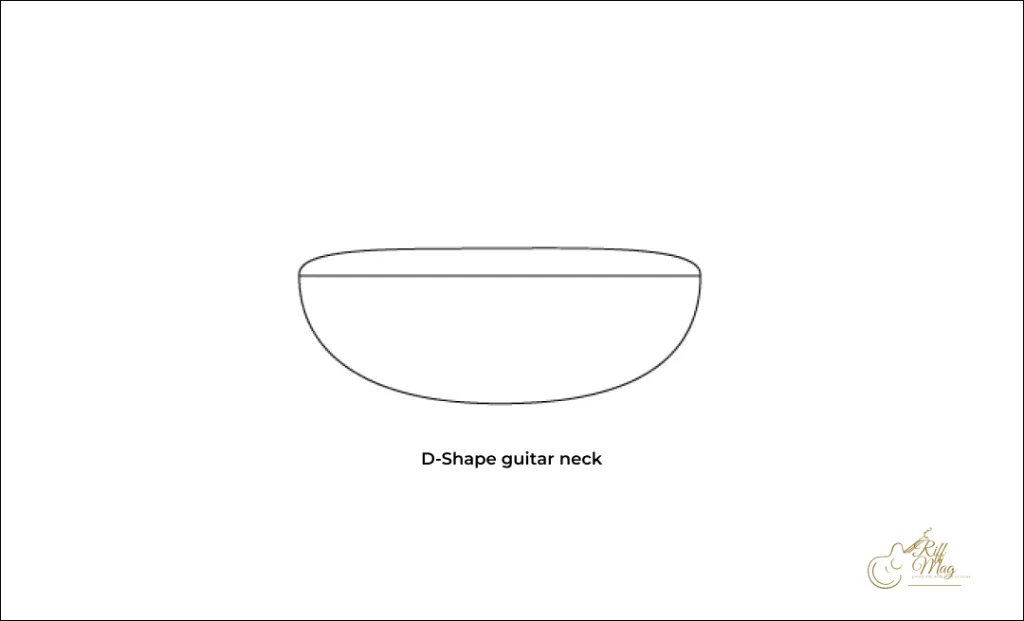
The D-shape is another popular neck style for guitars. The D shape is a modern design that takes the classic C shape and flattens the edges to create a comfortable ergonomic feel for fast passages.
This shape is particularly common with Ibanez Wizard necks and Epiphone models, which are targeted at beginner and improving guitarists. Popular models featuring this neck design include Ibanez RG series, Epiphone Sheraton, and various Les Paul and SG models by Epiphone.
It’s worth noting that this neck shape provides an incredibly comfortable experience whether you’re strumming or shredding.
Asymmetrical guitar necks
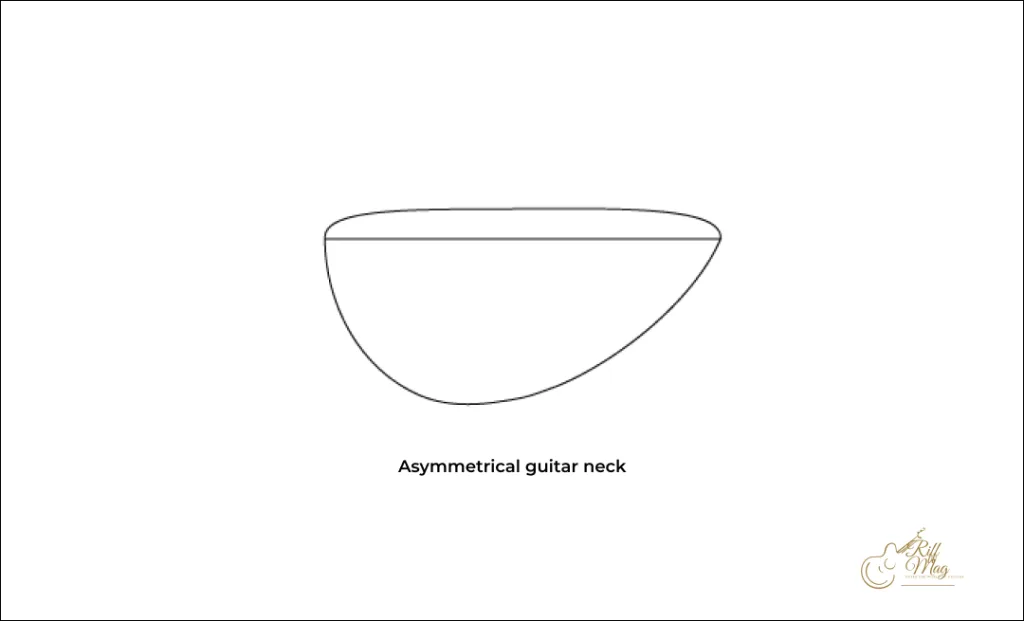
Asymmetrical necks offer the perfect balance between a comfortable grip and agile playability, making them a unique twist on traditional neck shapes – like getting two for the price of one!
With one side of the neck thicker than the other, your hand is able to maintain a secure grip while still allowing you to move freely.
Not only does it provide a better range of motion, but it also allows for easier transitions between chords and notes.
This neck design is also great for players who struggle with fatigue in their hands or wrists, as it provides extra support.
Popular models equipped with asymmetrical guitar necks include the EVH Wolfgang Standard and the 2018 Gibson Les Paul HP. These guitars are known for their comfort and playability, thanks in part to their ergonomic designs.
Guitar Neck Tonewoods
Regarding guitar necks, multiple kinds of wood can be used.
Multiple wood types of guitar necks
Combining two distinct kinds of wood, such as Mahogany and Maple, can offer a harmonious blend of warmth and brightness for your guitar’s neck. This is because the two kinds of wood complement each other in terms of their tonal qualities and resonance.
When the two are glued together, they form an incredibly strong bond, providing additional strength to the guitar neck than if it was just organic wood alone.
Manufacturing a guitar neck with multiple tones of wood is also often less expensive than using one piece of single-grain tonewood due to not needing as technical a production process.
Single wood type guitar necks
Single-piece necks on guitars can provide that purity some players desire in terms of sound, but it does come at a cost.
Not only is this method more expensive, but because there is no reinforcing glue, it makes them more susceptible to warping over time. Additionally, each tonewood has its signature sound, giving you more natural resonance when using single-piece necks on guitars.
Rosewood Guitar Necks
Rosewood guitar necks offer a unique blend of warmth and brightness. They provide an ideal balance of tonal qualities and sustain that can’t be found with other materials. It’s the perfect choice for players who want to take their sound to the next level.
Rosewood mutes overtones and smoothens out high frequencies. It also enhances the sustain and adds more presence to low and mid frequencies.
This creates a warm tone unmatched by other wood used in guitar construction.
The combination of warmth and brightness makes Rosewood an excellent choice for any playing style, from bright strumming chords to intricate fingerpicking leads.
Mahogany Guitar Necks
Mahagony wood has open pores, which can be felt if you run your finger over it. As sound vibrates through the wood, it is absorbed by these open pores, which softens and compresses the sound output for a big, fat tone that is smooth.
The downside, however, is that since it’s an open-grain wood, more work will need to be done in terms of finishing and smoothing out during manufacturing.
Maple Guitar Necks
Maple tonewood adds a bright, twangy tone to guitars, making it a great choice for those seeking a powerful sound.
Its even grain and smooth texture make it more reactive to vibrational energy, giving it an edge in the way of clarity and brightness.
It’s also less affected by climate changes, meaning its tuning is more consistent than other woods like mahogany.
Maple wood is also ideal for bolt-on neck designs, since its properties allow for better transfer of energy to the body.
Not only does this improve tone, but it also extends the life of the guitar by reducing wear and tear on parts like bridges and pickups.
You can see why Fender chose maple as their signature tone wood – its bright yet balanced sound makes it perfect for both beginners and experienced players.
Wenge Guitar Necks
The wenge guitar neck has brown stripes running through it, making it an ideal choice for bass guitars as it produces a strong mid-range sound. Combined with an ebony fretboard, makes the tone brighter and more balanced.
It also has less distinguished overtones than other woods, such as maple, allowing the mids to resonate more clearly.
The natural finish of this wood ensures that your instrument retains its unique look without having to apply any varnish or lacquer.
Koa Guitar Necks
With their warm and bright tones, Koa guitar necks balance Mahogany and Maple, giving you a top-end frequency range that’ll make your instrument stand out.
This type of neck is usually combined with an Ebony fretboard to further bring out its unique sound. As both kinds of wood are quite different in tonal characteristics, this combination helps to add complexity to the overall sound.
The combination of Ebony and Koa provides a great deal of definition in the bass and treble frequencies while also providing clarity in the mid-range. The result is a smooth yet powerful tone that can be heard clearly when playing complex chords or intricate solos.
Different types of guitar necks by construction
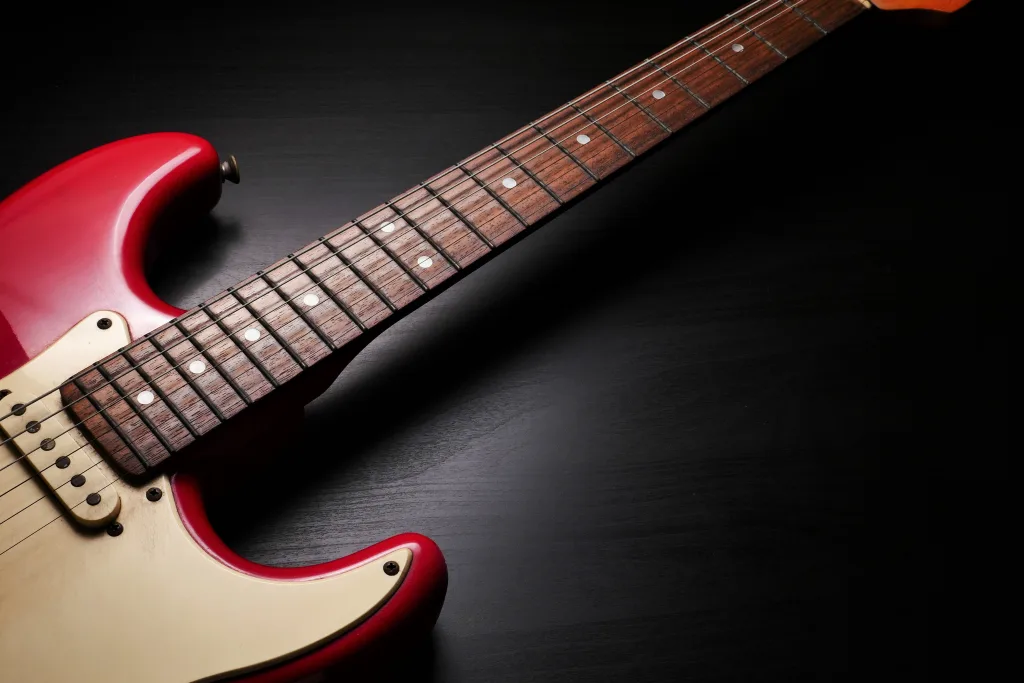
Different types of guitar necks regarding their construction are bolt-on necks, set necks, and neck-through guitars.
What is a Bolt-on guitar neck?
Bolt-on necks are among the most common types of guitar necks used today. The construction involves having a channel routed into the back of the body to accommodate the base of the neck, and then 3 or more bolts are run through both the neck and body to secure them together.
On top of being relatively cheap to manufacture, many people find that having a bolt-on neck can improve attack and provide a brighter tone. Additionally, if you ever have trouble adjusting action at one end, you can easily put in shims to adjust things accordingly – something that’s impossible with set or neck through necks.
What is a Set guitar neck?
Set neck guitars are an increasingly popular design amongst experienced luthiers due to their in-depth construction process.
This type of guitar secures the neck to the body with either a dovetail or mortise and tenon joint, as well as adhesive.
After being glued together, it’s clamped for several days to ensure a proper connection.
Gibson is one manufacturer that uses this technique almost exclusively on all their guitars, resulting in an iconic sound among musicians who prefer these guitars.
Set necks also provide great sustain when compared to bolt-on designs, which often lack this feature.
Guitarists looking for an instrument with these qualities should consider investing in a set neck guitar for its renowned performance benefit.
What is Neck through guitar?
Neck-through is a more complex design. Instead of the neck being attached to the body, as with set necks, the neck runs through the entire instrument length and forms its core. The wings are then joined to either side to complete construction.
Neck through guitars offer easy access to upper frets since there’s no heel required for stabilization. This also results in better intonation and better sustain than other designs.
Unfortunately, this complexity comes with drawbacks; if your neck through guitar gets damaged at all, especially near the upper frets, it might not be repairable or replaceable like you could do with a set neck design.
That’s why many high-end and boutique guitars use this design–they can produce extraordinary tones and sounds that just aren’t possible with other types of necks.
Conclusion
Understanding the various factors that influence a guitar neck’s shape and tonewoods will ensure you find one that best suits your needs.
Don’t let the abundance of options overwhelm you; instead, use this knowledge to find the perfect guitar neck for you!
FAQ
Are there any differences between electric and acoustic guitar necks?
Yes, there are noticeable differences between electric and acoustic guitar necks.
Electric guitar necks tend to be thinner and flatter than acoustic guitars, making them easier to finger for speedy solos or chord progressions.
Acoustic guitars’ necks are usually thicker, almost like a baseball bat in comparison. This makes it more comfortable for strumming chords with your fingertips or thumbpick.
Both types of guitar necks have their advantages; it all comes down to personal preference!
What is the best way to clean and maintain a guitar neck?
Cleaning and maintaining your guitar neck can be an important part of keeping it in good condition. To keep it looking its best, you should clean the fretboard regularly with a damp cloth or a specialized cleaner. Avoid using too much water as this could cause the wood to warp. If your frets are too worn out, you may have to replace them.
After cleaning, use a soft cloth to buff out any dirt or grime. You may also want to apply some oil or wax to protect the wood from wear and tear caused by playing. This will help keep your guitar neck looking great for years to come.

